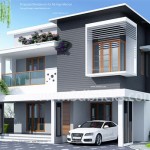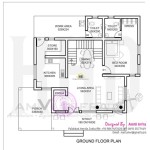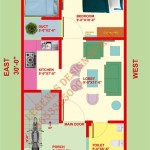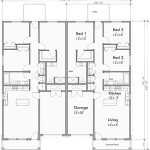Floor Plan Of A Roman Villa: An Architectural Overview
The Roman villa, a ubiquitous feature of the Roman countryside, was more than just a dwelling. It represented a center of agricultural, social, and economic activity. Understanding the floor plan of a Roman villa offers valuable insights into Roman life, social hierarchy, and architectural ingenuity. These structures varied considerably in size and complexity, from simple farmhouses to elaborate palatial residences, reflecting the wealth and status of their owners. This article will delve into the typical layout and key architectural features that characterized Roman villas, shedding light on the organization and functionality of these historical spaces.
Roman villas are generally classified into two main types: the *villa rustica* and the *villa urbana*. The *villa rustica* served primarily as a working farm, with its layout geared towards agricultural production and management. It included spaces for processing crops, housing livestock, and accommodating farm laborers. The *villa urbana*, on the other hand, was a more luxurious residence intended for leisure and comfort. While it might still have some agricultural function, its primary purpose was to provide a retreat from urban life for the wealthy elite. Often, a single estate would incorporate both a *villa rustica* and *villa urbana* section, creating a self-sufficient and multifaceted complex.
Key Features of the *Villa Rustica* Floor Plan
The floor plan of a *villa rustica* was dictated by its functional requirements. The central element was often the *pars rustica*, the working area of the farm. This section comprised numerous specialized spaces dedicated to agricultural activities. These areas were arranged around a central courtyard, facilitating efficient movement and communication within the complex.
Firstly, the *cella vinaria* or wine cellar was a crucial component, essential for producing and storing wine, a staple of the Roman diet and a valuable trade commodity. This space would house large earthenware jars known as *dolia*, partially buried in the ground to maintain a cool, stable temperature. The size of the *cella vinaria* would reflect the scale of wine production on the estate.
Secondly, the *cella olearia* or olive oil storage area was another significant feature. Similar to wine production, olive oil was a vital part of the Roman economy and diet. This section would involve facilities for pressing olives and storing the resulting oil in *dolia*. The presence of both a *cella vinaria* and *cella olearia* indicated a diversified agricultural output, contributing to the villa's economic self-sufficiency.
Thirdly, *stabula* or stables were integral for housing livestock, including oxen, horses, and other farm animals used for plowing, transportation, and providing manure. The *stabula* were typically located near the *pars rustica* to facilitate the efficient use of animal power in agricultural tasks. The precise layout and size of the *stabula* depended on the type and number of animals kept on the farm.
Fourthly, accommodation for farm laborers was a critical aspect of the *villa rustica*. These were typically simple rooms or dormitories located close to the working areas. The quality and size of these living quarters varied depending on whether the laborers were slaves or free tenant farmers. A well-organized *villa rustica* would provide adequate housing for its workforce to ensure the smooth operation of the agricultural enterprise.
Lastly, storage facilities for grain, tools, and other agricultural supplies were also essential. These spaces, often located near the *pars rustica*, provided secure and dry environments for preserving valuable resources. The efficient management of these storage areas was crucial for ensuring the continuity of agricultural production throughout the year.
Key Elements of the *Villa Urbana* Floor Plan
The floor plan of a *villa urbana* reflected its purpose as a luxurious retreat and a symbol of the owner’s wealth and status. It was characterized by carefully designed spaces intended for leisure, entertainment, and refined living. Distinct from the purely functional layout of the *villa rustica*, the *villa urbana* prioritized aesthetics and comfort.
Firstly, the *atrium* was the formal entrance hall, a central open space that served as the focal point of the *villa urbana*. It was often decorated with elaborate mosaics, frescoes, and sculptures, reflecting the owner's artistic tastes and social standing. The *atrium* provided access to other important rooms within the villa and created a grand impression for visitors.
Secondly, the *peristylium* was an open courtyard surrounded by a colonnade, providing a tranquil and aesthetically pleasing outdoor space. It typically featured a garden, fountains, and sculptures, offering a respite from the heat and noise of the surrounding environment. The *peristylium* served as a central gathering place for the family and their guests, promoting relaxation and social interaction.
Thirdly, the *triclinium* was the formal dining room, designed for hosting elaborate banquets and social gatherings. It usually featured three couches (*triclinia*) arranged around a central table, allowing guests to recline comfortably while dining. The *triclinium* was often decorated with opulent mosaics and frescoes, showcasing the owner's wealth and sophistication.
Fourthly, the *cubicula* were bedrooms used for sleeping and private activities. They were typically smaller and less ornamented than the public rooms, providing a more intimate and comfortable space for the villa's inhabitants. The layout and decoration of the *cubicula* reflected the individual tastes and preferences of their occupants.
Lastly, the *balnea* or baths were an essential feature of the *villa urbana*, reflecting the Roman emphasis on hygiene and well-being. The *balnea* typically included a series of rooms with different temperatures: the *caldarium* (hot bath), the *tepidarium* (warm bath), and the *frigidarium* (cold bath). The *balnea* were not only used for bathing but also as a social gathering place for the villa's inhabitants and their guests.
Variations and Adaptations in Villa Floor Plans
While the *villa rustica* and *villa urbana* represent two distinct types, the floor plans of Roman villas exhibited considerable variation and adaptation based on factors such as geographical location, climate, and the owner's specific needs and preferences. The availability of local building materials also influenced the construction and design of villas.
Firstly, villas located in coastal regions often incorporated features designed to take advantage of the sea views and breezes. These might include large terraces, balconies, and open-air dining areas overlooking the water. The proximity to the sea also facilitated trade and transportation, influencing the economic activities conducted at the villa.
Secondly, villas situated in mountainous regions often had terraced layouts to adapt to the uneven terrain. The terracing created level platforms for building and gardening, maximizing the use of the available space. The mountainous environment also provided natural resources such as stone and timber, which were used in the construction of the villa.
Thirdly, the climate played a significant role in shaping the floor plan of Roman villas. In warmer regions, villas were often designed with large open spaces and shaded courtyards to provide relief from the heat. In colder regions, villas were built with thicker walls and smaller windows to conserve heat. Heating systems, such as hypocausts (underfloor heating), were also more common in colder climates.
Fourthly, the size and complexity of the villa reflected the wealth and status of its owner. Wealthy landowners could afford to build elaborate villas with numerous rooms, luxurious amenities, and extensive gardens. Less affluent individuals might own smaller, simpler villas with fewer architectural embellishments. The scale of the villa was a visible indicator of the owner's social and economic standing.
Lastly, the specific function of the villa also influenced its floor plan. Some villas were primarily agricultural estates, while others served as country retreats for urban dwellers. The layout and features of the villa were tailored to its intended purpose, reflecting the owner's priorities and lifestyle. Understanding the specific function of a villa is crucial for interpreting its floor plan and architectural features.
In summary, the floor plan of a Roman villa provides a rich source of information about Roman society, economy, and architectural practices. Understanding the distinction between the *villa rustica* and *villa urbana*, as well as the variations and adaptations influenced by geographical location, climate, and owner preferences, allows for a nuanced appreciation of these historical structures. The careful arrangement of spaces within the villa reflected the functional requirements of agricultural production, the pursuit of leisure and comfort, and the social dynamics of Roman life.

Ancient Roman Villa Floor Plan

Roman Houses And Villas

The Roman Domus House Architecture And Reconstruction

Roman Villa Floor Plan With Courtyard And Pool

Smarthistory Roman Domestic Architecture The Domus

Plan Of A Pompeian House

Roman House

House Of The Vine Museums Victoria
Plan And Elevation Of A Roman Villa Nypl Digital Collections

Seeking Floor Plan Of A Classical Roman Building With 20 To 30 Rooms History Stack Exchange








